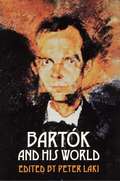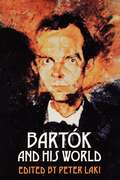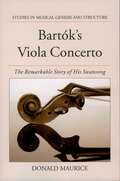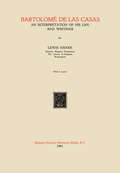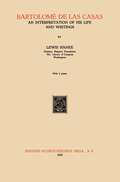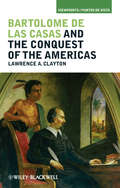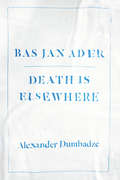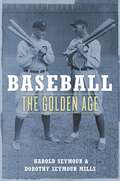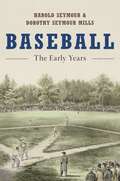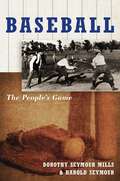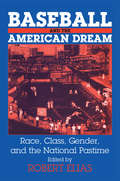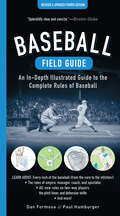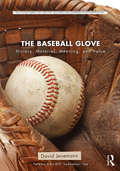- Table View
- List View
Barth Reception in Britain
by D. Densil MorganThis is the first book length assessment in English of the impact of Karl Barth's theology in Britain. Beginning with the essays of Adolf Keller and H.R. Mackintosh in the 1920s, it analyses the interplay between Barth's developing thought and different strands of English, Scottish and Welsh church history up to the 1980s. Barth's impact on British perceptions of the German Church Struggle during the 1930s is discussed, along with the ready acceptance that his theology gained among the English Congregationalists, Welsh Nonconformists and theologians of the Church of Scotland. Half forgotten names such as John McConnachie and Nathaniel Micklem are brought to light along with better known representatives of British Barthianism like Daniel T. Jenkins and T.F. Torrance. Barth and the secular theology of the 1960s are assessed, along with the beginnings of the Barthian renaissance linked with Colin Gunton and others during the 1980s. Barth Reception in Britain is a contribution to modern church history as well as the history of doctrine.
Bartók and His World (The Bard Music Festival #50)
by Peter LakiBéla Bartók, who died in New York fifty years ago this September, is one of the most frequently performed twentieth-century composers. He is also the subject of a rapidly growing critical and analytical literature. Bartók was born in Hungary and made his home there for all but his last five years, when he resided in the United States. As a result, many aspects of his life and work have been accessible only to readers of Hungarian. The main goal of this volume is to provide English-speaking audiences with new insights into the life and reception of this musician, especially in Hungary. Part I begins with an essay by Leon Botstein that places Bartók in a large historical and cultural context. László Somfai reports on the catalog of Bartók's works that is currently in progress. Peter Laki shows the extremes of the composer's reception in Hungary, while Tibor Tallián surveys the often mixed reviews from the American years. The essays of Carl Leafstedt and Vera Lampert deal with his librettists Béla Balázs and Melchior Lengyel respectively. David Schneider addresses the artistic relationship between Bartók and Stravinsky. Most of the letters and interviews in Part II concern Bartók's travels and emigration as they reflected on his personal life and artistic evolution. Part III presents early critical assessments of Bartók's work as well as literary and poetic responses to his music and personality.
Bartók and His World (PDF)
by Peter LakiBéla Bartók, who died in New York fifty years ago this September, is one of the most frequently performed twentieth-century composers. He is also the subject of a rapidly growing critical and analytical literature. Bartók was born in Hungary and made his home there for all but his last five years, when he resided in the United States. As a result, many aspects of his life and work have been accessible only to readers of Hungarian. The main goal of this volume is to provide English-speaking audiences with new insights into the life and reception of this musician, especially in Hungary. Part I begins with an essay by Leon Botstein that places Bartók in a large historical and cultural context. László Somfai reports on the catalog of Bartók's works that is currently in progress. Peter Laki shows the extremes of the composer's reception in Hungary, while Tibor Tallián surveys the often mixed reviews from the American years. The essays of Carl Leafstedt and Vera Lampert deal with his librettists Béla Balázs and Melchior Lengyel respectively. David Schneider addresses the artistic relationship between Bartók and Stravinsky. Most of the letters and interviews in Part II concern Bartók's travels and emigration as they reflected on his personal life and artistic evolution. Part III presents early critical assessments of Bartók's work as well as literary and poetic responses to his music and personality.
Bartok's Viola Concerto: The Remarkable Story of His Swansong (Studies In Musical Genesis, Structure, and Interpretation)
by Donald MauriceWhen Bela Bartók died in September of 1945, he left a partially completed viola concerto commissioned by the virtuoso violist William Primrose. Yet, while no definitive version of the work exists, this concerto has become arguably the most-performed viola concerto in the world. The story of how the concerto came to be, from its commissioning by Primrose to its first performance to the several completions that are performed today is told here in Bartók's Viola Concerto:The Remarkable Story of His Swansong. After Bartók's death, his family asked the composer's friend Tibor Serly to look over the sketches of the concerto and to prepare it for publication. While a draft was ready, it took Serly years to assemble the sketches into a complete piece. In 1949, Primrose finally unveiled it, at a premiere performance with the Minneapolis Symphony Orchestra. For almost half a century, the Serly version enjoyed great popularity among the viola community, even while it faced charges of inauthenticity. In the 1990s, several revisions appeared and, in 1995, the composer's son, Peter Bartók, released a revision, opening the way or an intensified debate on the authenticity of the multiple versions. This debate continues as violists and Bartók scholars seek the definitive version of this final work of Hungary's greatest composer. Bartók's Viola Concerto tells the story of the genesis and completion of Bartók's viola concerto, its reception over the second half of the twentieth century, its revisions, and future possibilities.
Bartolomé de las Casas and the Conquest of the Americas (Viewpoints / Puntos De Vista Ser. #15)
by ClaytonThis is a short history of the age of exploration and the conquest of the Americas told through the experience of Bartolomé de las Casas, a Dominican friar who fervently defended the American Indians, and the single most important figure of the period after Columbus. Explores the period known as the Encounter, which was characterized by intensive conflict between Europeans and the people of the Americas following Columbus’s voyages Argues that Las Casas, ‘protector of Indians,' was primarily motivated by Scripture in his crusade for justice and equality for American Indians Draws on the 14 volume Complete Works of Las Casas as a window into his mind and actions Encourages students to understand history through the viewpoint of individuals living it
Bartolomé de las Casas and the Conquest of the Americas
by Lawrence A. ClaytonThis is a short history of the age of exploration and the conquest of the Americas told through the experience of Bartolomé de las Casas, a Dominican friar who fervently defended the American Indians, and the single most important figure of the period after Columbus. Explores the period known as the Encounter, which was characterized by intensive conflict between Europeans and the people of the Americas following Columbus’s voyages Argues that Las Casas, ‘protector of Indians,' was primarily motivated by Scripture in his crusade for justice and equality for American Indians Draws on the 14 volume Complete Works of Las Casas as a window into his mind and actions Encourages students to understand history through the viewpoint of individuals living it
Bas Jan Ader: Death Is Elsewhere
by Alexander DumbadzeOn July 9, 1975, Dutch-born artist Bas Jan Ader set sail from Chatham, Massachusetts, on a thirteen-foot sailboat. He was bound for Falmouth, England, on the second leg of a three-part piece titled In Search of the Miraculous. The damaged boat was found south of the western tip of Ireland nearly a year later. Ader was never seen again. Since his untimely death, Ader has achieved mythic status in the art world as a figure literally willing to die for his art. Considering the artist’s legacy and concise oeuvre beyond the romantic and tragic associations that accompany his peculiar end, Alexander Dumbadze resituates Ader’s art and life within the conceptual art world of Los Angeles in the early 1970s and offers a nuanced argument about artistic subjectivity that explains Ader’s tremendous relevance to contemporary art. Bas Jan Ader blends biography, theoretical reflection, and archival research to draw a detailed picture of the world in which Ader’s work was rooted: a vibrant international art scene populated with peers such as Ger van Elk, William Leavitt, and Allen Ruppersberg. Dumbadze looks closely at Ader’s engagement with questions of free will and his ultimate success in creating art untainted by mediation. The first in-depth study of this enigmatic conceptual artist, Bas Jan Ader is a thoughtful reflection on the necessity of the creative act and its inescapable relation to death.
Bas Jan Ader: Death Is Elsewhere
by Alexander DumbadzeOn July 9, 1975, Dutch-born artist Bas Jan Ader set sail from Chatham, Massachusetts, on a thirteen-foot sailboat. He was bound for Falmouth, England, on the second leg of a three-part piece titled In Search of the Miraculous. The damaged boat was found south of the western tip of Ireland nearly a year later. Ader was never seen again. Since his untimely death, Ader has achieved mythic status in the art world as a figure literally willing to die for his art. Considering the artist’s legacy and concise oeuvre beyond the romantic and tragic associations that accompany his peculiar end, Alexander Dumbadze resituates Ader’s art and life within the conceptual art world of Los Angeles in the early 1970s and offers a nuanced argument about artistic subjectivity that explains Ader’s tremendous relevance to contemporary art. Bas Jan Ader blends biography, theoretical reflection, and archival research to draw a detailed picture of the world in which Ader’s work was rooted: a vibrant international art scene populated with peers such as Ger van Elk, William Leavitt, and Allen Ruppersberg. Dumbadze looks closely at Ader’s engagement with questions of free will and his ultimate success in creating art untainted by mediation. The first in-depth study of this enigmatic conceptual artist, Bas Jan Ader is a thoughtful reflection on the necessity of the creative act and its inescapable relation to death.
Bas Jan Ader: Death Is Elsewhere
by Alexander DumbadzeOn July 9, 1975, Dutch-born artist Bas Jan Ader set sail from Chatham, Massachusetts, on a thirteen-foot sailboat. He was bound for Falmouth, England, on the second leg of a three-part piece titled In Search of the Miraculous. The damaged boat was found south of the western tip of Ireland nearly a year later. Ader was never seen again. Since his untimely death, Ader has achieved mythic status in the art world as a figure literally willing to die for his art. Considering the artist’s legacy and concise oeuvre beyond the romantic and tragic associations that accompany his peculiar end, Alexander Dumbadze resituates Ader’s art and life within the conceptual art world of Los Angeles in the early 1970s and offers a nuanced argument about artistic subjectivity that explains Ader’s tremendous relevance to contemporary art. Bas Jan Ader blends biography, theoretical reflection, and archival research to draw a detailed picture of the world in which Ader’s work was rooted: a vibrant international art scene populated with peers such as Ger van Elk, William Leavitt, and Allen Ruppersberg. Dumbadze looks closely at Ader’s engagement with questions of free will and his ultimate success in creating art untainted by mediation. The first in-depth study of this enigmatic conceptual artist, Bas Jan Ader is a thoughtful reflection on the necessity of the creative act and its inescapable relation to death.
Bas Jan Ader: Death Is Elsewhere
by Alexander DumbadzeOn July 9, 1975, Dutch-born artist Bas Jan Ader set sail from Chatham, Massachusetts, on a thirteen-foot sailboat. He was bound for Falmouth, England, on the second leg of a three-part piece titled In Search of the Miraculous. The damaged boat was found south of the western tip of Ireland nearly a year later. Ader was never seen again. Since his untimely death, Ader has achieved mythic status in the art world as a figure literally willing to die for his art. Considering the artist’s legacy and concise oeuvre beyond the romantic and tragic associations that accompany his peculiar end, Alexander Dumbadze resituates Ader’s art and life within the conceptual art world of Los Angeles in the early 1970s and offers a nuanced argument about artistic subjectivity that explains Ader’s tremendous relevance to contemporary art. Bas Jan Ader blends biography, theoretical reflection, and archival research to draw a detailed picture of the world in which Ader’s work was rooted: a vibrant international art scene populated with peers such as Ger van Elk, William Leavitt, and Allen Ruppersberg. Dumbadze looks closely at Ader’s engagement with questions of free will and his ultimate success in creating art untainted by mediation. The first in-depth study of this enigmatic conceptual artist, Bas Jan Ader is a thoughtful reflection on the necessity of the creative act and its inescapable relation to death.
Bas Jan Ader: Death Is Elsewhere
by Alexander DumbadzeOn July 9, 1975, Dutch-born artist Bas Jan Ader set sail from Chatham, Massachusetts, on a thirteen-foot sailboat. He was bound for Falmouth, England, on the second leg of a three-part piece titled In Search of the Miraculous. The damaged boat was found south of the western tip of Ireland nearly a year later. Ader was never seen again. Since his untimely death, Ader has achieved mythic status in the art world as a figure literally willing to die for his art. Considering the artist’s legacy and concise oeuvre beyond the romantic and tragic associations that accompany his peculiar end, Alexander Dumbadze resituates Ader’s art and life within the conceptual art world of Los Angeles in the early 1970s and offers a nuanced argument about artistic subjectivity that explains Ader’s tremendous relevance to contemporary art. Bas Jan Ader blends biography, theoretical reflection, and archival research to draw a detailed picture of the world in which Ader’s work was rooted: a vibrant international art scene populated with peers such as Ger van Elk, William Leavitt, and Allen Ruppersberg. Dumbadze looks closely at Ader’s engagement with questions of free will and his ultimate success in creating art untainted by mediation. The first in-depth study of this enigmatic conceptual artist, Bas Jan Ader is a thoughtful reflection on the necessity of the creative act and its inescapable relation to death.
Bas Jan Ader: Death Is Elsewhere
by Alexander DumbadzeOn July 9, 1975, Dutch-born artist Bas Jan Ader set sail from Chatham, Massachusetts, on a thirteen-foot sailboat. He was bound for Falmouth, England, on the second leg of a three-part piece titled In Search of the Miraculous. The damaged boat was found south of the western tip of Ireland nearly a year later. Ader was never seen again. Since his untimely death, Ader has achieved mythic status in the art world as a figure literally willing to die for his art. Considering the artist’s legacy and concise oeuvre beyond the romantic and tragic associations that accompany his peculiar end, Alexander Dumbadze resituates Ader’s art and life within the conceptual art world of Los Angeles in the early 1970s and offers a nuanced argument about artistic subjectivity that explains Ader’s tremendous relevance to contemporary art. Bas Jan Ader blends biography, theoretical reflection, and archival research to draw a detailed picture of the world in which Ader’s work was rooted: a vibrant international art scene populated with peers such as Ger van Elk, William Leavitt, and Allen Ruppersberg. Dumbadze looks closely at Ader’s engagement with questions of free will and his ultimate success in creating art untainted by mediation. The first in-depth study of this enigmatic conceptual artist, Bas Jan Ader is a thoughtful reflection on the necessity of the creative act and its inescapable relation to death.
Base Colonies in the Western Hemisphere, 1940–1967 (Studies of the Americas)
by S. HighThis book examines the social, economic and political aftermath of the famous Anglo-American 'destroyers-for-bases' deal of 2nd September 1940 that saw fifty obsolete U.S. destroyers exchanged for 'base colonies' in Trinidad, Bermuda, Newfoundland and the Bahamas.
Baseball: The Golden Age
by Harold Seymour Dorothy Seymour MillsIn Baseball: The Golden Age, Harold Seymour and Dorothy Seymour Mills explore the glorious era when the game truly captured the American imagination, with such legendary figures as Babe Ruth and Ty Cobb in the spotlight. Beginning with the formation of the two major leagues in 1903, when baseball officially entered its "golden age" of popularity, the authors examine the changes in the organization of professional baseball--from an unwieldy three-man commission to the strong one-man rule of Judge Kenesaw Mountain Landis. They depicts how the play on the field shifted from the low-scoring, pitcher-dominated game of the "dead ball" era before World War I to the higher scoring of the 1920's "lively ball" era, with emphasis on home runs, best exemplified by the exploits of Babe Ruth. Note: On August 2, 2010, Oxford University Press made public that it would credit Dorothy Seymour Mills as co-author of the three baseball histories previously "authored" solely by her late husband, Harold Seymour. The Seymours collaborated on Baseball: The Early Years (1960), Baseball: The Golden Age (1971) and Baseball: The People's Game (1991).
Baseball: The Early Years
by Harold Seymour Dorothy Seymour MillsNow available in paperback, Harold Seymour and Dorothy Seymour Mills' Baseball: The Early Years recounts the true story of how baseball came into being and how it developed into a highly organized business and social institution. The Early Years, traces the growth of baseball from the time of the first recorded ball game at Valley Forge during the revolution until the formation of the two present-day major leagues in 1903. By investigating previously unknown sources, the book uncovers the real story of how baseball evolved from a gentleman's amateur sport of "well-bred play followed by well-laden banquet tables" into a professional sport where big leagues operate under their own laws. Offering countless anecdotes and a wealth of new information, the authors explode many cherished myths, including the one which claims that Abner Doubleday "invented" baseball in 1839. They describe the influence of baseball on American business, manners, morals, social institutions, and even show business, as well as depicting the types of men who became the first professional ball players, club owners, and managers, including Spalding, McGraw, Comiskey, and Connie Mack. Note: On August 2, 2010, Oxford University Press made public that it would credit Dorothy Seymour Mills as co-author of the three baseball histories previously "authored" solely by her late husband, Harold Seymour. The Seymours collaborated on Baseball: The Early Years (1960), Baseball: The Golden Age (1971) and Baseball: The People's Game (1991).
Baseball: The Early Years
by Harold Seymour Dorothy Seymour MillsNow available in paperback, Harold Seymour and Dorothy Seymour Mills' Baseball: The Early Years recounts the true story of how baseball came into being and how it developed into a highly organized business and social institution. The Early Years, traces the growth of baseball from the time of the first recorded ball game at Valley Forge during the revolution until the formation of the two present-day major leagues in 1903. By investigating previously unknown sources, the book uncovers the real story of how baseball evolved from a gentleman's amateur sport of "well-bred play followed by well-laden banquet tables" into a professional sport where big leagues operate under their own laws. Offering countless anecdotes and a wealth of new information, the authors explode many cherished myths, including the one which claims that Abner Doubleday "invented" baseball in 1839. They describe the influence of baseball on American business, manners, morals, social institutions, and even show business, as well as depicting the types of men who became the first professional ball players, club owners, and managers, including Spalding, McGraw, Comiskey, and Connie Mack. Note: On August 2, 2010, Oxford University Press made public that it would credit Dorothy Seymour Mills as co-author of the three baseball histories previously "authored" solely by her late husband, Harold Seymour. The Seymours collaborated on Baseball: The Early Years (1960), Baseball: The Golden Age (1971) and Baseball: The People's Game (1991).
Baseball: The Golden Age
by Harold Seymour Dorothy Seymour MillsIn Baseball: The Golden Age, Harold Seymour and Dorothy Seymour Mills explore the glorious era when the game truly captured the American imagination, with such legendary figures as Babe Ruth and Ty Cobb in the spotlight. Beginning with the formation of the two major leagues in 1903, when baseball officially entered its "golden age" of popularity, the authors examine the changes in the organization of professional baseball--from an unwieldy three-man commission to the strong one-man rule of Judge Kenesaw Mountain Landis. They depicts how the play on the field shifted from the low-scoring, pitcher-dominated game of the "dead ball" era before World War I to the higher scoring of the 1920's "lively ball" era, with emphasis on home runs, best exemplified by the exploits of Babe Ruth. Note: On August 2, 2010, Oxford University Press made public that it would credit Dorothy Seymour Mills as co-author of the three baseball histories previously "authored" solely by her late husband, Harold Seymour. The Seymours collaborated on Baseball: The Early Years (1960), Baseball: The Golden Age (1971) and Baseball: The People's Game (1991).
Baseball: The People's Game
by Harold Seymour Dorothy Seymour MillsIn Baseball: The People's Game, Dorothy Seymour Mills and Harold Seymour produce an authoritative, multi-volume chronicle of America's national pastime. The first two volumes of this study -The Early Years and The Golden Age -won universal acclaim. The New York Times wrote that they "will grip every American who has invested part of his youth and dreams in the sport," while The Boston Globe called them "irresistible." Now, in The People's Game, the authors offer the first book devoted entirely to the history of the game outside of the professional leagues, revealing how, from its early beginnings up to World War II, baseball truly became the great American pastime. They explore the bond between baseball and boys through the decades, the game's place in institutions from colleges to prisons to the armed forces, the rise of women's baseball that coincided with nineteenth century feminism, and the struggles of black players and clubs from the later years of slavery up to the Second World War. Whether discussing the birth of softball or the origins of the seventh inning stretch, the Seymours enrich their extensive research with fascinating details and entertaining anecdotes as well as a wealth of baseball experience. The People's Game brings to life the central role of baseball for generations of Americans. Note: On August 2, 2010, Oxford University Press made public that it would credit Dorothy Seymour Mills as co-author of the three baseball histories previously "authored" solely by her late husband, Harold Seymour. The Seymours collaborated on Baseball: The Early Years (1960), Baseball: The Golden Age (1971) and Baseball: The People's Game (1991).
Baseball: The People's Game
by Dorothy Seymour Mills Harold SeymourIn Baseball: The People's Game, Dorothy Seymour Mills and Harold Seymour produce an authoritative, multi-volume chronicle of America's national pastime. The first two volumes of this study -The Early Years and The Golden Age -won universal acclaim. The New York Times wrote that they "will grip every American who has invested part of his youth and dreams in the sport," while The Boston Globe called them "irresistible." Now, in The People's Game, the authors offer the first book devoted entirely to the history of the game outside of the professional leagues, revealing how, from its early beginnings up to World War II, baseball truly became the great American pastime. They explore the bond between baseball and boys through the decades, the game's place in institutions from colleges to prisons to the armed forces, the rise of women's baseball that coincided with nineteenth century feminism, and the struggles of black players and clubs from the later years of slavery up to the Second World War. Whether discussing the birth of softball or the origins of the seventh inning stretch, the Seymours enrich their extensive research with fascinating details and entertaining anecdotes as well as a wealth of baseball experience. The People's Game brings to life the central role of baseball for generations of Americans. Note: On August 2, 2010, Oxford University Press made public that it would credit Dorothy Seymour Mills as co-author of the three baseball histories previously "authored" solely by her late husband, Harold Seymour. The Seymours collaborated on Baseball: The Early Years (1960), Baseball: The Golden Age (1971) and Baseball: The People's Game (1991).
Baseball and the American Dream: Race, Class, Gender, and the National Pastime
by Robert EliasA fascinating look at how America's favorite sport has both reflected and shaped social, economic, and
Baseball and the American Dream: Race, Class, Gender, and the National Pastime
by Robert EliasA fascinating look at how America's favorite sport has both reflected and shaped social, economic, and
Baseball Field Guide, Fourth Edition: An In-Depth Illustrated Guide to the Complete Rules of Baseball
by Dan Formosa Paul HamburgerA great overview for novices and a precise reference guide for devoted fans!Admit it: Even if you&’re a die-hard fan of our national pastime, sometimes an umpire's call can be baffling. And for newer fans, Major League Baseball's nuanced rules—developed and revised over many decades—can be downright perplexing. Now updated throughout with the latest changes, including specifications about the universal designated hitter and limits on defensive shifts, the Baseball Field Guide lays out every rule in plain English. You&’ll learn to answer all these questions and more: Do you know the twenty-two ways a pitcher can be charged with a balk? Can you list all seven ways a batter can safely get to first base? Obstruction or interference—who&’s at fault when things get rough? What are the rules that apply before and after a game? What happens when spectators are the ones who misbehave? How well do you understand the infamous Infield Fly Rule (and why does it exist)? This is the clearest explanation anywhere of the rules of baseball. Designed for quick and intuitive searches, this entertaining reference will help you understand every aspect of the game and add to your enjoyment of the sport.
The Baseball Glove: History, Material, Meaning, and Value (Routledge Series for Creative Teaching and Learning in Anthropology)
by David JenemannThe baseball glove is a ubiquitous item, a crucial piece of equipment in the game of baseball, and it offers the opportunity to examine the production of material culture and social practice at numerous levels. Where and how is a glove made, and how does its manufacture square with the narratives surrounding its place in American cultural life? What are the myths, superstitions, and beliefs surrounding its acquisition, care, use, and significance? How does a glove function as the center of a web of cultural practices that illustrate how individuals relate to a consumer good as a symbol of memory, personal narrative, and national identity? How do the manufacturers of baseball gloves draw upon, promote, and in some sense create these practices? How do these practices and meanings change in other national and cultural contexts? The Baseball Glove offers students the opportunity to examine these questions in an engagingly written and illustrated book that promotes hands-on interaction with a quintessential item of material culture. At the same time, the book gives students the space for critical self-reflection about the place of material goods like sporting equipment in their lives, and it provides the chance to learn different methodological approaches to studying everyday objects.

